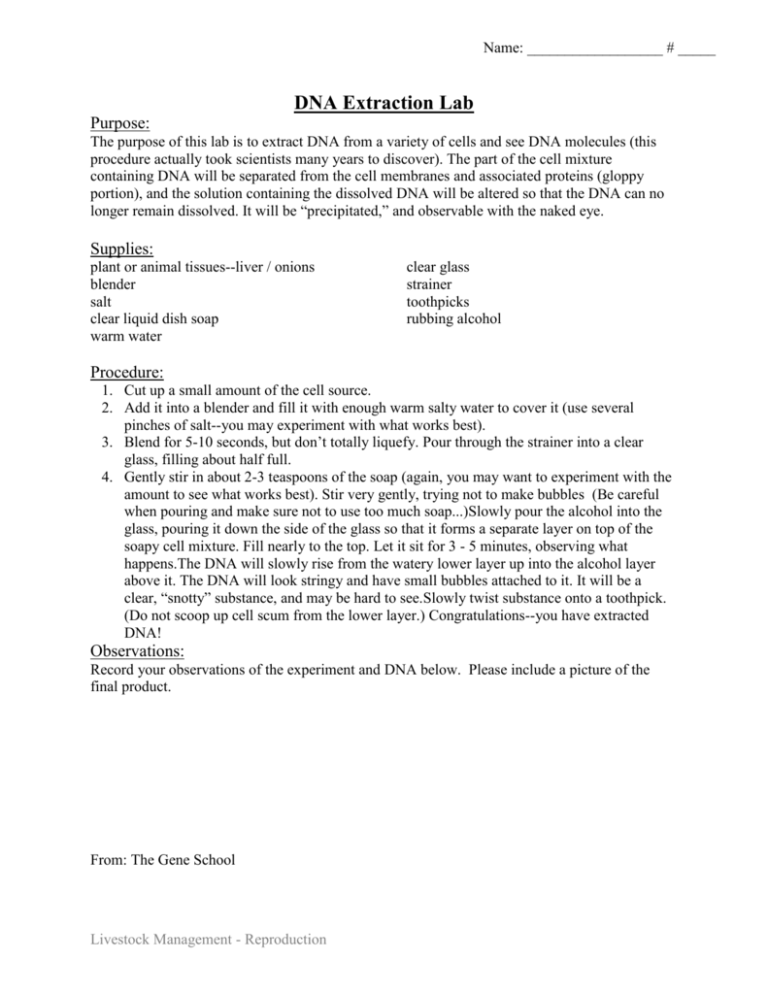DNA Extraction
advertisement

Name: __________________ # _____ DNA Extraction Lab Purpose: The purpose of this lab is to extract DNA from a variety of cells and see DNA molecules (this procedure actually took scientists many years to discover). The part of the cell mixture containing DNA will be separated from the cell membranes and associated proteins (gloppy portion), and the solution containing the dissolved DNA will be altered so that the DNA can no longer remain dissolved. It will be “precipitated,” and observable with the naked eye. Supplies: plant or animal tissues--liver / onions blender salt clear liquid dish soap warm water clear glass strainer toothpicks rubbing alcohol Procedure: 1. Cut up a small amount of the cell source. 2. Add it into a blender and fill it with enough warm salty water to cover it (use several pinches of salt--you may experiment with what works best). 3. Blend for 5-10 seconds, but don’t totally liquefy. Pour through the strainer into a clear glass, filling about half full. 4. Gently stir in about 2-3 teaspoons of the soap (again, you may want to experiment with the amount to see what works best). Stir very gently, trying not to make bubbles (Be careful when pouring and make sure not to use too much soap...)Slowly pour the alcohol into the glass, pouring it down the side of the glass so that it forms a separate layer on top of the soapy cell mixture. Fill nearly to the top. Let it sit for 3 - 5 minutes, observing what happens.The DNA will slowly rise from the watery lower layer up into the alcohol layer above it. The DNA will look stringy and have small bubbles attached to it. It will be a clear, “snotty” substance, and may be hard to see.Slowly twist substance onto a toothpick. (Do not scoop up cell scum from the lower layer.) Congratulations--you have extracted DNA! Observations: Record your observations of the experiment and DNA below. Please include a picture of the final product. From: The Gene School Livestock Management - Reproduction Name: __________________ # _____ DNA Extraction Lab Results, Questions: 1. What does the salt do? 2. What does the blender do? 3. When you mix the blended cell source with the soap, what is happening? 4. What does the alcohol do? Why does the DNA rise to the top after adding alcohol? 5. If you try a seed food such as peas, there will be more protein residue in the liquid. Why? 6. Why can’t you see the double helix? 7. What part of the cell did the DNA come from? Livestock Management - Reproduction Name: __KEY_____________ # _____ DNA Extraction Lab Results, Questions: 1. What does the salt do? (Salt provides the DNA with a favorable environment; it contributes positively charged atoms that neutralize the normal negative charge of DNA.) 2. What does the blender do? (help break down the cell walls) 3. When you mix the blended cell source with the soap, what is happening? (In the experiment, the enzymes in the soap are breaking down the lipid molecules of the cell and nuclear membranes, releasing the contents of the cell, including the DNA. These enzymes in the soap are what break down grease while washing dishes.) 4. What does the alcohol do? Why does the DNA rise to the top after adding alcohol? (DNA will not dissolve in this alcohol, so the DNA comes out of the solution, or precipitates. It is less dense than water or cell scum--which is what settles to the bottom of the glass--so it floats up into the alcohol layer, where you see it as a snotty, string-like substance, with small bubbles formed on it.) 5. If you try a seed food such as peas, there will be more protein residue in the liquid. Why? (Because protein is stored in them for the nutrition of the new plant.) 6. Why can’t you see the double helix? (It is too small to be seen with the naked eye. What you extracted is millions of strands of DNA.) 7. What part of the cell did the DNA come from? (99% is from the nucleus.) Livestock Management - Reproduction







